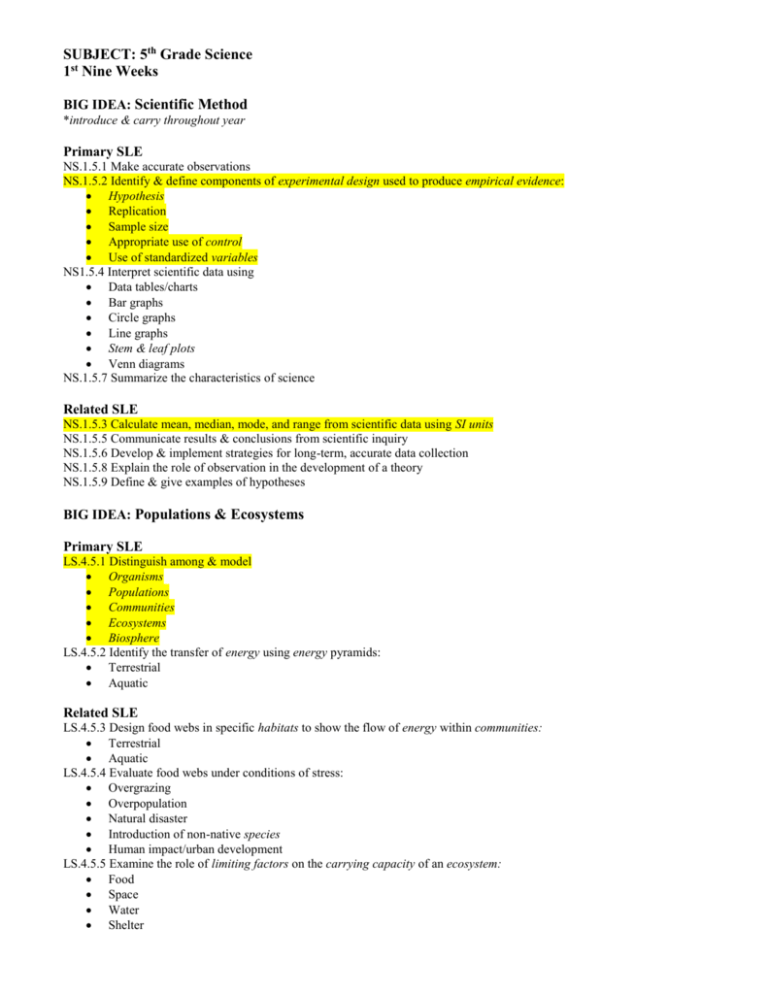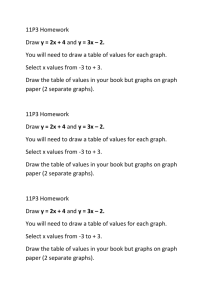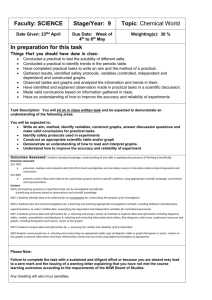SUBJECT: 5th Grade Science
advertisement

SUBJECT: 5th Grade Science 1st Nine Weeks BIG IDEA: Scientific Method *introduce & carry throughout year Primary SLE NS.1.5.1 Make accurate observations NS.1.5.2 Identify & define components of experimental design used to produce empirical evidence: Hypothesis Replication Sample size Appropriate use of control Use of standardized variables NS1.5.4 Interpret scientific data using Data tables/charts Bar graphs Circle graphs Line graphs Stem & leaf plots Venn diagrams NS.1.5.7 Summarize the characteristics of science Related SLE NS.1.5.3 Calculate mean, median, mode, and range from scientific data using SI units NS.1.5.5 Communicate results & conclusions from scientific inquiry NS.1.5.6 Develop & implement strategies for long-term, accurate data collection NS.1.5.8 Explain the role of observation in the development of a theory NS.1.5.9 Define & give examples of hypotheses BIG IDEA: Populations & Ecosystems Primary SLE LS.4.5.1 Distinguish among & model Organisms Populations Communities Ecosystems Biosphere LS.4.5.2 Identify the transfer of energy using energy pyramids: Terrestrial Aquatic Related SLE LS.4.5.3 Design food webs in specific habitats to show the flow of energy within communities: Terrestrial Aquatic LS.4.5.4 Evaluate food webs under conditions of stress: Overgrazing Overpopulation Natural disaster Introduction of non-native species Human impact/urban development LS.4.5.5 Examine the role of limiting factors on the carrying capacity of an ecosystem: Food Space Water Shelter LS.4.5.6 Describe & diagram the nitrogen cycle in ecosystems LS.4.5.7 Describe & diagram the carbon cycle in ecosystems LS.4.5.8 Describe & diagram the carbon dioxide-oxygen cycle in ecosystems LS.4.5.9 Conduct investigations demonstrating the role of the carbon dioxide-oxygen cycle in ecosystems LS.4.5.10 Analyze the concept of conservation of mass as related to the amount of matter in an ecosystem LS.4.5.11 Create ecosystems in which plants can exist without animals LS.4.5.12 Conduct investigations in which plants are encouraged to thrive LS.4.5.13 Construct, compare, & contrast environments in open & closed aquaria LS.4.5.14 Categorize organisms by the function they serve in ecosystems and food webs: Predatorlprey Parasitism Producer/ consumer/ decomposer Scavenger Herbivore/ carnivore/ omnivore LS.4.5.15 Conduct field studies identifying & categorizing organisms in a given area of an ecosystem LS.4.5.16 Evaluate positive & negative human effect on ecosystems LS.4.5.17 Describe & illustrate various symbiotic relationships: Parasitism Mutualism Commensalisms LS.4.5.18 Investigate careers, scientists, & historical breakthroughs related to populations and ecosystems SUBJECT: 5th Grade Science 2nd Nine Weeks BIG IDEA: Living Systems Primary SLE LS.2.5.1 Compare the cell theory to the characteristics of a scientific theory LS.2.5.3 Describe the similarities of basic cell functions in all organisms LS.2.5.5 Compare & contrast plant & animal cells LS.2.5.4 Model & identify the parts of animal cells and plant cells: Cell wall Cell membrane Nucleus Cytoplasm Chloroplast Related SLE LS.2.5.2 Examine cells on a microscopic level LS.2.5.8 Explain & illustrate photosynthesis NS.1.5.1 Make accurate observations NS.1.5.2 Identify & define components of experimental design used to produce empirical evidence: Hypothesis Replication Sample size Appropriate use of control Use of standardized variables NS.1.5.3 Calculate mean, median, mode, and range from scientific data using SI units NS1.5.4 Interpret scientific data using Data tables/charts Bar graphs Circle graphs Line graphs Stem & leaf plots Venn diagrams NS.1.5.5 Communicate results & conclusions from scientific inquiry NS.1.5.6 Develop & implement strategies for long-term, accurate data collection NS.1.5.8 Explain the role of observation in the development of a theory NS.1.5.9 Define & give examples of hypotheses LS.2.5.6 Conduct investigations to separate plant pigments from the cell LS.2.5.7 Identify the role of chlorophyll in the process of photosynthesis LS.2.5.9 Explain cellular respiration LS.2.5.10 Conduct investigations demonstrating the process of cellular respiration LS.2.5.11 Investigate careers, scientists & historical breakthroughs related to cells BIG IDEA: Objects in the Universe Primary SLE ESS.10.5.1 Compare the physical characteristics of the sun to other stars: Size Color Brightness ESS.10.5.2 Demonstrate the order of planets & other space objects in our solar system ESS.10.5.4 Distinguish between mass and weight Related SLE NS.1.5.1 Make accurate observations NS.1.5.2 Identify & define components of experimental design used to produce empirical evidence: Hypothesis Replication Sample size Appropriate use of control Use of standardized variables NS.1.5.3 Calculate mean, median, mode, and range from scientific data using SI units NS1.5.4 Interpret scientific data using Data tables/charts Bar graphs Circle graphs Line graphs Stem & leaf plots Venn diagrams NS.1.5.5 Communicate results & conclusions from scientific inquiry NS.1.5.6 Develop & implement strategies for long-term, accurate data collection NS.1.5.9 Define & give examples of hypotheses ESS.10.5.3 Compare the properties of planets in our solar system: Size Shape Density Atmosphere Distance from the sun Orbital path Moons Surface Composition ESS.10.5.5 Compare the human body’s mass to weight on Earth, the moon, & the other planets in our solar system ESS.10.5.6 Investigate careers, scientists, & historical breakthroughs related to planets SUBJECT: 5th Grade Science 3rd Nine Weeks BIG IDEA: Rocks & Minerals Primary SLE ESS.8.5.3 Identify characteristics of minerals ESS.8.5.9 Classify the 3 basic types of rocks ESS.8.5.12 Conduct investigations on sedimentation ESS.9.5.2 Analyze fossil record evidence about plants & animals that lived long ago Related SLE NS.1.5.1 Make accurate observations NS.1.5.2 Identify & define components of experimental design used to produce empirical evidence: Hypothesis Replication Sample size Appropriate use of control Use of standardized variables NS.1.5.3 Calculate mean, median, mode, and range from scientific data using SI units NS1.5.4 Interpret scientific data using Data tables/charts Bar graphs Circle graphs Line graphs Stem & leaf plots Venn diagrams NS.1.5.5 Communicate results & conclusions from scientific inquiry NS.1.5.6 Develop & implement strategies for long-term, accurate data collection NS.1.5.9 Define & give examples of hypotheses ESS.8.5.1 Identify some basic elements composing minerals: Silicon Oxygen Iron Sodium Chlorine Calcium Carbon Hydrogen Aluminum ESS.8.5.2 Investigate the growth of crystals ESS.8.5.4 Conduct investigations on mineral properties: Luster Hardness Streak Acid test for calcite Fluorescence ESS.8.5.5 Identify the following minerals: Halite (salt) Feldspar Sulfur Quartz Diamonds Gypsum Calcite Talc Hematite (iron) Precious metals (gold, silver) ESS.8.5.6 Identify minerals found in Arkansas: Bauxite Diamonds Quartz Galena ESS.8.5.7 Identify characteristics of sedimentary, igneous, & metamorphic rocks ESS.8.5.8 Compare & contrast by investigation characteristics of the 3 basic types of rocks: Sedimentary Igneous Metamorphic ESS.8.5.10 Investigate careers, scientists, & historical breakthroughs related to minerals & rocks ESS.8.5.11 Investigate the formation of soil ESS.8.5.13 Describe & illustrate the rock cycle ESS.9.5.1 Explain & give examples of how physical evidence from fossils supports the theory that Earth has changed over time ESS.9.5.3 Infer the nature of ancient environments based on fossil record evidence BIG IDEA: Matter Primary SLE PS.5.5.1 Identify the relationship of atoms to all matter PS.5.5.3 Identify common examples of physical properties: Length Mass Area Perimeter Texture Taste Odor Color Elasticity PS.5.5.5 Identify characteristics and common examples of physical changes Related SLE NS.1.5.1 Make accurate observations NS.1.5.2 Identify & define components of experimental design used to produce empirical evidence: Hypothesis Replication Sample size Appropriate use of control Use of standardized variables NS.1.5.3 Calculate mean, median, mode, and range from scientific data using SI units NS1.5.4 Interpret scientific data using Data tables/charts Bar graphs Circle graphs Line graphs Stem & leaf plots Venn diagrams NS.1.5.5 Communicate results & conclusions from scientific inquiry NS.1.5.6 Develop & implement strategies for long-term, accurate data collection NS.1.5.9 Define & give examples of hypotheses PS.5.5.2 Conduct scientific investigations on physical properties of objects PS.5.5.4 State characteristics of physical changes PS.5.5.6 Explain how heat influences the states of matter of a substance: Solid Liquid Gas Plasma PS.5.5.7 Demonstrate the effect of changes in the physical properties of matter PS5.5.8 Model the motion & position of molecules in solids, liquids, & gases in terms of kinetic energy PS.5.5.9 Conduct investigations demonstrating expansion and contraction PS.5.5.10 Investigate scientists, careers, & historical breakthroughs related to physical properties, physical changes, & states of matter SUBJECT: 5th Grade Science 4th Nine Weeks BIG IDEA: Energy Primary SLE PS.7.5.1 Summarize how light can interact with matte through absorption, refraction, and reflection Related SLE NS.1.5.1 Make accurate observations NS.1.5.2 Identify & define components of experimental design used to produce empirical evidence: Hypothesis Replication Sample size Appropriate use of control Use of standardized variables NS.1.5.3 Calculate mean, median, mode, and range from scientific data using SI units NS1.5.4 Interpret scientific data using Data tables/charts Bar graphs Circle graphs Line graphs Stem & leaf plots Venn diagrams NS.1.5.5 Communicate results & conclusions from scientific inquiry NS.1.5.6 Develop & implement strategies for long-term, accurate data collection NS.1.5.7 Summarize the characteristics of science PS.7.5.2 Investigate how light travels and interacts with an object or material PS.7.5.3 Conduct investigations demonstrating how an object can be seen PS.7.5.4 Design and conduct investigations of transparent, translucent, and opaque as applied to light PS.7.5.5 Investigate physical interactions of light and matter and the effect on color perception: Refraction Absorption Transmission Scattering PS.7.5.6 Investigate careers, scientists, & historical breakthroughs related to light energy BIG IDEA: Motion & Forces Primary SLE PS.6.5.1 Classify simple machines PS.6.5.4 Compare & contrast potential energy and kinetic energy as applied to motion Related SLE NS.1.5.1 Make accurate observations NS.1.5.2 Identify & define components of experimental design used to produce empirical evidence: Hypothesis Replication Sample size Appropriate use of control Use of standardized variables NS.1.5.3 Calculate mean, median, mode, and range from scientific data using SI units NS1.5.4 Interpret scientific data using Data tables/charts Bar graphs Circle graphs Line graphs Stem & leaf plots Venn diagrams NS.1.5.5 Communicate results & conclusions from scientific inquiry NS.1.5.6 Develop & implement strategies for long-term, accurate data collection NS.1.5.7 Summarize the characteristics of science PS.6.5.2 Conduct investigations using Levers (e.g. toothbrush) Pulleys Inclined planes-ramps, wedges, & screws Wheels & axles PS.6.5.3 Relate simple machines to inventions & discoveries PS.6.5.5 Classify real world examples as potential energy or kinetic energy as applied to motion PS.6.5.6 Conduct investigations using potential energy & kinetic energy PS.6.5.7 Investigate careers, scientists, & historical breakthroughs related to simple machines and potential energy & kinetic energy BIG IDEA: Living Systems (Review) Primary SLE LS.4.5.11 Create ecosystems in which plants can exist without animals LS.4.5.12 Conduct investigations in which plants are encouraged to thrive LS.4.5.15 Conduct field studies identifying & categorizing organisms in a given area of an ecosystem Related SLE NS.1.5.1 Make accurate observations NS.1.5.2 Identify & define components of experimental design used to produce empirical evidence: Hypothesis Replication Sample size Appropriate use of control Use of standardized variables NS.1.5.3 Calculate mean, median, mode, and range from scientific data using SI units NS1.5.4 Interpret scientific data using Data tables/charts Bar graphs Circle graphs Line graphs Stem & leaf plots Venn diagrams NS.1.5.5 Communicate results & conclusions from scientific inquiry






